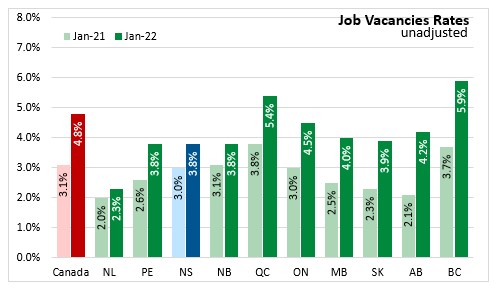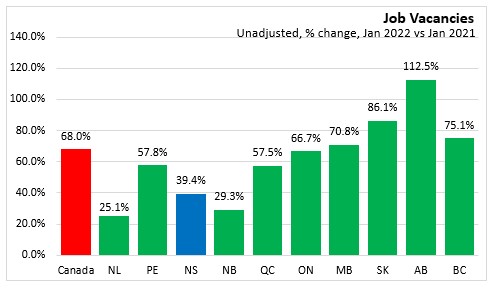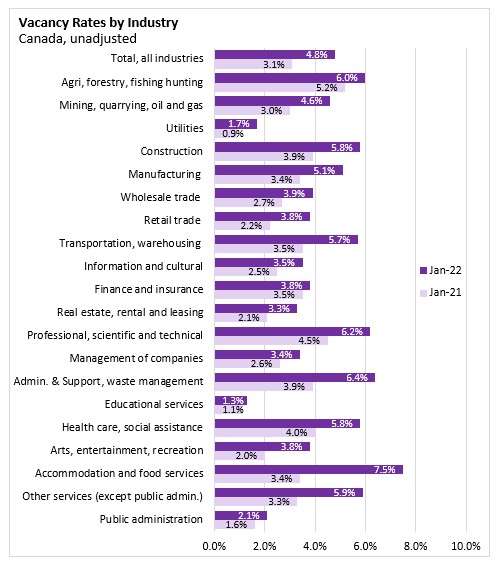The Economics and Statistics Division maintains archives of previous publications for accountability purposes, but makes no updates to keep these documents current with the latest data revisions from Statistics Canada. As a result, information in older documents may not be accurate. Please exercise caution when referring to older documents. For the latest information and historical data, please contact the individual listed to the right.
<--- Return to Archive
For additional information relating to this article, please contact:
March 29, 2022JOB VACANCIES, JANUARY 2022 Statistics Canada released today monthly results from the Job Vacancy and Wage Survey (JVWS) for January 2022.
Nova Scotia had 16,570 job vacancies in January 2022 with a vacancy rate of 3.8%. Canadian employers were actively recruiting for 830,680 positions (not seasonally adjusted) in January with a vacancy rate of 4.8%. The highest vacancy rates were reported in British Columbia and Quebec, while the lowest vacancy rate was reported in Newfoundland and Labrador. Compared to January 2021, the job vacancy rate was higher in January 2022 for all provinces.

The number of vacancies declined 4.3% from the previous month in Nova Scotia. Vacancies were down in all provinces except Manitoba and Alberta. Nationally, job vacancies declined 5.4% from December. Newfoundland and Labrador posted the highest month-over-month decline in job vacancies in January. Note that job vacancy data are not adjusted for seasonal patterns.


Nova Scotia job vacancies were 39.4% higher than they were one year ago. The number of vacancies were up in all provinces compared to January 2021, with the largest growth in vacancies being in Alberta and Saskatchewan. Newfoundland and Labrador and New Brunswick reported the lowest increase in January 2022 compared with one year ago.

Nationally, health care and social assistance sector had the highest number of job vacancies at 134,905, with a job vacancy rate of 5.8%. Job vacancies in professional, scientific and technical services reached an all-time high of 73,565 in January 2022 with a job vacancy rate of 6.2% since the data series began in October 2020.
Accommodation and food services sector had the highest vacancy rate in January. While the job vacancy rate in the sector declined from 10.8% in December 2021 to 7.5% in January, it remained the highest among all sectors for the ninth consecutive month.
Administrative and support, waste management and remediation services and professional, scientific and technical services had the next highest vacancy rate. The lowest vacancy rate was for educational services and utilities in January 2022. Job vacancy rates were up for every industry at the national level compared to one year ago.

Notes: The job vacancy rate is a key indicator of labour market conditions. The job vacancy rate is the percentage of job positions (both filled and vacant) that are vacant. A higher job vacancy rate indicates a tighter labour market where it is more difficult for employers to find suitable candidates for the positions offered. A lower job vacancy rate signals labour market slack and potentially more job seekers competing for each vacant position.
Information on monthly job vacancies will continue in future Statistics Canada releases, and a more detailed analysis will be released with quarterly estimates from the Job Vacancy and Wage Survey.
Sources: Statistics Canada, Table 14-10-0371-01 Job vacancies, payroll employees, and job vacancy rate by provinces and territories, monthly, unadjusted for seasonality; Table 14-10-0372-01 Job vacancies, payroll employees, and job vacancy rate by industry sector, monthly, unadjusted for seasonality
<--- Return to Archive